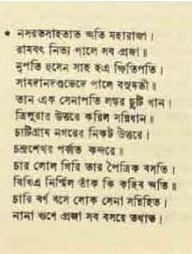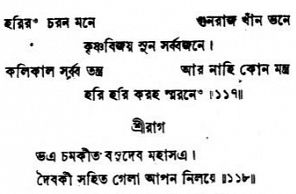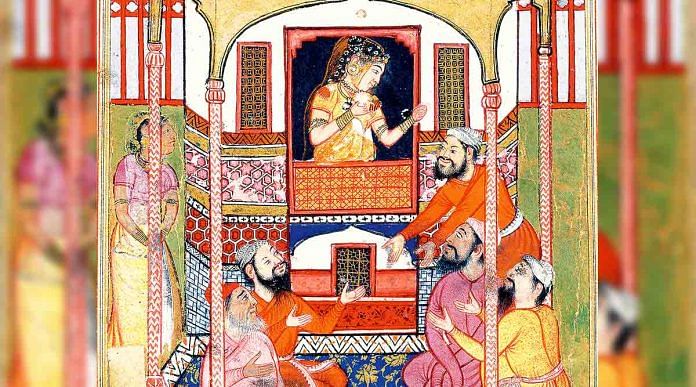On Janmashtami, as the Kashi-Mathura temple debate rages after the Ayodhya bhoomi pujan, it is important to focus not just on the binary of victory and defeat, but also on coexistence. Little is known about how Islamic rulers patronised coexistence through both literary and administrative means.
Hussain Shahi’s Krishna biography
The Hussain Shahi (1493-1538) dynasty of Bengal were great patrons of Krishna’s bhakti literature, and the little-known financiers of possibly the first Bangla Mahabharata. Indeed, the Bangla epic came to be composed soon after their chief general Paragal Khan’s conquest of Chittagong. The newly victorious Paragal Khan became interested in learning the epic and requested Kabindra Parameshwara to compose a suitable rendition in Bangla. The text, taking great cognisance of this endowment, begins with lengthy praise of the peaceful and benedictory rule of the Hussain Shahis in Bengal. The sultan is not only addressed as “a valiant warrior” and “a famed ruler”, but also called the Ishwara of Gauda and compared to Krishna (Sen 1911, p. 202)

The text was most likely completed during the reign of Chutti Khan (‘choto’ meaning junior), who much like his father continued to be a great patron. And, Srikarna Nandi was assigned as the poet. However, some scholars say that Paragal Khan and Chutti Khan’s Mahabharatas were in fact two distinct accounts. Nandi likened the prosperity of the Hussain Shahi rule with Rama’s kingdom, and praised him for upholding the Hindu codes of Sama-Dana-Danda-Bheda.
Nasratshahtāta ati Mahārājā
Rāmbat nitya Pāle Shob Prajā
Nṛpati Hussainshāh Hae ḳhitipatī
Sāmadānadaṇḍa bhede pale Basumatī (Sen 1911, p. 204)

Also read: Indians know all about Draupadi and Sita, but ignore what was done to Subhadra in Mahabharata
Patronage of Mahabharata
Recitations of the epic at the Shahi courts were also encouraged, and the nobles were active listeners. Indeed, Nandi noted that Chutti Khan had been inspired to sponsor the composition of the tale after intently listening to the Sanskrit recitation of the abridged Jaimini Mahabharata — Jaiminibharata — in his court. Historian Sukumar Sen argues that these courtly recitations, which had stopped altogether after the dissolution of the Pala dynasty, were revived during this period.
Another notable feature of the time was the composition of Krishna’s biographies. Maladhar Basu, who was granted the title Gunaraj Khan by Ruknuddin Barbak Shah (who preceded Hussain Shah), composed his immensely popular Srikrishna Bijay, a Bangla rendition of the final cantos of the Srimad Bhagavatam. Throughout the text, he chooses to sign as Gunaraj Khan, as is evident from one of his introductory verses:
Thinking of Hari’s feet, Gunaraj Khan composes
Srikrishnavajaya, Oh’ all, listen

Yashoraj Khan, also known as Damodar Sen, composed a similar narrative poem titled Srikrishnamangala, (Sukumar Sen 1960, p. 70) under the patronage of Hussain Shahis. This work, unfortunately, isn’t available anymore, but the essential information has survived through quotations in later 17th-century texts.
Also read: In the call for Ram’s Mandir, the birth of Sita continues to be a mystery
Mughal connection with Vrindavan
The period between 1500-1800 CE witnessed a major political shift in north India — the expansion of the Mughal empire — and with it, a resounding boom of Vaishnava devotionalism. Many scholars have elaborately demonstrated how the growth of Vaishnava bhakti in the medieval north Indian heartland frequently came at the expense of Shiva-Shakti worship (Vaudeville 1976; Pauwels 2009, 2010; Orsini and Sheikh 2014). However, our concern here is to chiefly trace how Mughal patronage benefited the medieval Vaishnava heartland.
Akbar was a patron of the Vaishnava tradition and was known for his many grants and endowments — the earliest being in 1565 to the priest of Govindadeva temple (Burchett 2019, p. 118). Akbar kept granting lands to temples till the last years of his reign. This is evident from how he “enlarged and consolidated all grants to temples and temple-servants in the Mathura region by his farmans of 4 and 19 Shahriwar 43 Ilahi year (27 August and 11 September 1598), which provided for a total grant of 1,000 bighas of land to 35 temples in Mathura, Vrindavan and their environs” (Mukherjee and Habib 1988, pp. 287-300).
It is also interesting to note, as Pika Ghosh points out to demonstrate the Hindu-Muslim syncretism of the site, “the series of five early temples (Madanmohan, Gopinath, Radha Vallabh, Jugal Kishor, and Govindadeva)… flaunt the red sandstone marked unmistakably by their immediately precedent use at Akbar’s capital at Fatehpur Sikri” (Ghosh 2002, p. 205). Further evidence suggests that “Vaishnavas belonging to different sampradayas (communities) — including Bengalis of the Chaitanya sect — who… gathered in Mathura–Brindavan, quite regularly petitioned and lobbied the imperial durbar for the settlement of grievances as well as for additional land and other material grants” (Chatterjee 2009, p. 156).
Akbar was, however, not alone in his household in his support for Vaishnavism. Hamida Banu, his mother, had particularly supported the Vallabha sampradaya. In 1581, in no uncertain terms, she ordered that “the cows of Vithaleshwar may graze wherever they are and not a single individual of the Khalisa and jagirdar should molest them or prevent them. They must allow his cows to graze and the aforesaid person should feel perfectly at ease” (Edicts from the Mughal Harem 2009, p. 4).
Jahangir not only continued Akbar’s grants but added considerably to it. He turned Todar Mal’s 1584 grant of 100 bighas into a permanent imperial grant “in favour of Srichand, Gopaldas’s successor, as sevak of the temple of Madan Mohan. That is, it was no longer resumable by jagirdars” (Mukherjee, Habib 1988, p. 288). He also financed the construction of two temples, one in Vrindavan and another in Mathura, and issued a number of grants to the influential gurus: Kamadev Acharya and sons received 24 bighas in 1612, Narayan Das and sons 12 bighas in 1612, Brindaban Das and Nanda Lal 50 bighas in 1612, Swamidas 20 bighas in 1613, and Shyam Krishan 15 bighas in 1615 (ibid.). Shahjahan, faced with a dwindling treasury, wasn’t nearly as open-handed as his predecessors when it came to temple-grants, but he nonetheless preserved the earlier ones (Ibid., p. 288).
Also read: The tale of two Ayodhya archaeologists who changed the way we dig up India’s Hindu history
Looking into the past
What necessitated Islamic patronage of Vaishnav texts and sites? Was it personal proclivities? The influences of sectarian leaders (Chatterjee 2009)? Marital alliances (Burchett 2019)? Or administrative matters (Rana 2006)? There are too many reasons to be summed up here. Nonetheless, even a brief engagement with the available scholarship is bound to demonstrate the complexity and interconnectedness of the pre-modern religious history of the subcontinent.
After the Ram Mandir bhoomi pujan in Ayodhya on 5 August, many Right-wing public intellectuals have claimed that “rebuilding is a civilisational responsibility Indians owe to their ancestors”. This cannot be possibly more anachronistic. As one can see, it is not rebuilding where our responsibility lies, but rather in preserving our united efforts, preserving India’s multicultural and heterogenous religious histories that we often overlook due to populist, rhetorical hyperbole. In this regard, one might as well look for inspiration in this syncretic, and now routinely demonised, past.
The authors are graduate students of history and art history at Mcgill University and the University of Wisconsin-Madison. Views are personal.







Proselytizing religions eliminated and continue to eliminate Hinduism/pagan religions.
Proof of this is the conversion of crores of Hindus and the creation of West/East Pakistan and the exodus of Hindus from Afghanistan 1000 years back.
I appreciate the people you have mentioned, but that does not change the fact so don’t hide one truth with another truth.
Omg, seriously. O esteemed writers of this unfinished article. Please write about the JIJIYA tax too, oh and the MURDER of sikh leaders for NOT giving up their religion and ACCEPTING ISLAM. Also the FORCED conversions of KSHATRIYAS defeated in WAR against them. Also how they forced HINDU rajas to marry their daughters off to them but they NEVER married their daughters to a hindu prince.
This article reads like it has been written by middle schoolers and ANACHRONISTIC was their word of the day.
Why do we forget what happened to our own Kashmiri pandits? Pretty interesting that the secular Islamic Kashmiris (I am aware of a few genuine Kashmiris who are Indian by heart & behavior even today & this excludes such genuine people) of Islam changed the demographics of Kashmir by forceful conversions, horrible rapes, murders of Hindu pandits in 1990 but now claim they are being targetted when their misdemeanor is rectified! The pinnacle of hypocrisy!
What happened to countries likeIran, Syria, Indonesia etc whose original people were Parsis, Christians, Hindus respectively under Dar-Ul-Islam?? The same forced conversions, rape, murder of so called kafirs. What is happening to minorities in Pakistan? Minorities population in Hindustan has grown significantly. But, what nonsense did Warris Pathan blabber (regarding 15 crore Muslims hitting out at a much larger Hindu majority) during CAA discussions? Do you know about Moplah genocide in the Malabar region of Hindustan? Who wanted Bhaarath Varsha to be divided along religious lines but Mohammad Ali Jinnah? Read some history before penning things down. Sanaatana dharma itself inherently supports genuine thoughts of various schools of Vedanta. Can we not see the writing on the wall? This post cannot hurt genuine Muslim Indian greats like Dr. Abdul Kalam.
Fools can best reserve their ignorance to their own hearts. Read real history before vomiting fallacies about pseudo-secularism.
These are not authors but thieves ..What muslims did to hindus is clearly visible in present day pakistan..
Typical SELECTIVE INTERPRETATTION of HISTORY. These so called History experts are busy air brushing HISTORY to show OPPRESSIVE MUGHALS as EPITOME OF SECULARISM.
Yet another futile attempt by SICKULAR MEDIA to paint a different picture of COMMUNAL AND OPPRESSIVE MUGHALS!!!
This apologist commentary and posting an odd benevolent ruler is rubbish. The same can be said about English rule in India. As a collective, the Islamic rule was ungly and horrible for the natives. I use the term natives to all people of Indian origin. This includes converted Muslims as well. This kind of journalism is a disservice.
Someone needs to do a deep study on why a certain class of Bengali Hindus feels a deep need for virtue signalling and this kind of woke behaviour.
These are two graduate students (studying Indian history in the US ?) selectively picking exceptions to create a narrative.
This is not the result of a an academic study that involves rigor but just a pre decided “finding ” substantiated by a few cherry picked exceptions.
Indian students going to US/Canadian/UK universities to study Indian history and philosophy. Heights of irony.
The likes of Wendy Doniger and Audrey Truschke salivate at the prospect of such naive and gullible young minds. These Indian students make perfect fodder for their cannons. Over a period of six-seven years they will slowly but steadily indoctrinate such students and then the students will return with a PhD from a “prestigious” US university to land a professorship at an Indian university. They, in turn, will further indoctrinate their students, so on and so forth. The cycle continues.
The mantra is simple – lay the blame for all evils at the door of Hinduism. Whatever the topic might be (it hardly matters anyway), blame the Hindu. Vilify and denigrate Hindu heritage and culture – Sanskrit language and literature being an all time favourite target.
At the same time, portray Islam/Christianity as a superior religion with superior philosophical schools and material heritage.
Either the authors are naive or pretending to be. One sided cherry picked narratives are no longer credible. Especially when there is a vast body of evidence from the past as well as in present behaviour to the contrary. For eg. the mob violence in Bengaluru. Obviously there will be those who the authors describe but even more are/ were those of the opposite temperament. History bears evidence to repeated destruction of places of worship, libraries, universities and entire communities. No amount of whitewashing can hide this.
Pretty vacuous article i must say. Perhaps this space could have been utilized for something better.
The authors have very cleverly swept under the carpet the ugly history of Kalapahad. Born as Rajiblochan Roy – he converted to Islam in his youth. As a Muslim general, he sacked, looted and burnt every single Hindu temple in Bengal.
Even a cursory glance through the pages of history will be enough for anyone to determine the veracity of this. But our liberal/secular cabal wont mention this. It goes against their ideology and agenda.
Bengalis are a strange race. They lost more than two-thirds of their land (present day Bangladesh) to Islamic fanaticism yet their love and admiration for Islam and anything Islamic remains undying. Maybe a second division of Bengal, oops West Bengal, will put some sense into them.
One doesn’t have to get carried away by these chosen exceptions, which will not be more than 1 % of the total non-Hindus’ either literary or cultural history. The other 99 % is nothing but doing down Hinduism, calling Hindu goddesses as prostitutes and forcing citizens to convert to non-Hindu religions. Akbar was the only exception to the general ethnic cleansing that other emperors tried to do. Ethnic cleansing in Kashmir was done in the 19th century also. That Hinduism has survived is not acceptable to these non-Hindus and attempts are still on to erase Indian culture.
please do not whitewash Islamic Barbarism, if Muslims are so tolerant and patronaged Hindu temples, who destroyed 80,000 Hindu temples and how come Hindus are killed in millions and forcefully converted, finally if Muslim are so tolerant then why Muslims divided India and created Islamic Pakistan so violently, the truth is Muslims will be good and peaceful as long as they are in Minority that too below 5 percent of the population, with their population growth, they will wipe out Non-Muslims, its just a matter of time. History is the witness for that demographic change.
PS 1000 Bhigas is equal to 400 Acres, so, All Hindu temples got 400 acres as grants from Muslim KIngs in history, great
Mandir aapke abbu ne tode the.
Kuch bhi likhte ho. Readers ko idiots samajh rakha he.
tum dogle log kitne bhi farzi story bnao or connection nikalo par mandir toh banega mathura main…thodi or farzi story socho bhait k abhi kashi bhi baaki hai ussey bhi related khuch narrative dhoond loh